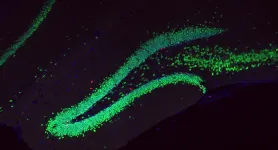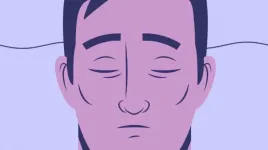(Press-News.org) The first ever vaccine target for trypanosomes, a family of parasites that cause devastating disease in animals and humans, has been discovered by scientists at the Wellcome Sanger Institute. By targeting a protein on the cell surface of the parasite Trypanosoma vivax, researchers were able to confer long-lasting protection against animal African trypanosomiasis (AAT) infection in mice.
The study, published today (26 May 2021) in Nature, is the first successful attempt to induce apparently sterile immunity against a trypanosome parasite. A vaccine was long thought impossible due to the sophisticated ability of the parasites to evade the host immune system. As well as a strong vaccine target for AAT, the findings raise the possibility of identifying vaccine targets for trypanosome species that cause the deadly human infections sleeping sickness and Chagas' disease.
Animal African trypanosomiasis (AAT) is a disease affecting livestock in Africa and, more recently, South America. It is caused by several species of Trypanosoma parasite, which are transmitted by tsetse flies, causing animals to suffer from fever, weakness, lethargy and anaemia. The resulting weight loss, low fertility and reduced milk yields have a huge economic impact on the people who depend on these animals. The disease has been said to lie at the heart of poverty in Africa1.
In humans, a disease called sleeping sickness is caused by infection with another trypanosome species, Trypanosoma brucei. Although control efforts have reduced the number of infections each year considerably, 65 million people remain at risk. In South America, the potentially life-threatening infection Chagas' disease is caused by Trypanosoma cruzi and affects at least 6 million people living in endemic areas2.
All trypanosome species have developed sophisticated anti-immune mechanisms that allow the parasites to thrive in their host. For example, African trypanosomes display a protein on their surface that constantly changes and prevents host antibodies from recognising the pathogen. Until now, it was thought impossible to vaccinate against trypanosome infection for this reason.
In this study, scientists at the Wellcome Sanger Institute analysed the genome of T. vivax to identify 60 cell surface proteins that could be viable vaccine targets. Each protein was produced using mammalian cell lines and then used to vaccinate mice to determine if the host immune system had been instructed to identify and destroy the T. vivax parasite.
One cell surface protein, named 'invariant flagellum antigen from T. vivax' (IFX), was observed to confer immunity against infection in almost all vaccinated mice for at least 170 days after experimental challenge with T. vivax parasites.
Dr Delphine Autheman, first author of the study from the Wellcome Sanger Institute, said: "Scientists have been searching for a way to vaccinate against animal African trypanosomiasis (AAT) since the parasite and vector were first discovered in the early 20th century. We've heard a lot about vaccines recently, but compared to a virus protozoan parasites have a huge number of proteins, making it very difficult to identify the right targets. Several of the 60 targets we tested elicited a partial immune response, but only one conferred the long-lasting protection that makes it a promising vaccine candidate."
Though drugs exist to prevent or treat AAT, many communities that require them live in remote locations that are difficult to access. Reliance on a handful of drugs, and a lack of professional expertise in their administration, are thought to be contributing to increased drug resistance in the parasites3. An effective vaccine would help to overcome some of these practical barriers.
Dr Andrew Jackson, a senior author of the study from the University of Liverpool, said: "It was considered impossible to vaccinate against trypanosome parasites because of the sophisticated immune-protective mechanisms they have evolved, so I'm delighted that we have been able to demonstrate that this can be done. Beyond the obvious benefit of a strong vaccine candidate for animal trypanosomiasis, the genome-led vaccine approach we outline in this study is one that could potentially be applied to other trypanosome species and other parasite families."
The next step will be to validate the results using a cattle model. If successful, work could begin on developing a vaccine for AAT that would be an important tool for tackling poverty in affected regions.
Dr Gavin Wright, a senior author of the study from the Wellcome Sanger Institute and the University of York, said: "This study is an important first step toward relieving the burden of animal African trypanosomiasis (AAT) on both animals and humans in Africa and South America. The protective effect of the vaccine target we identified will first need to be replicated in a cattle model, but I think we can be cautiously optimistic that in a few years' time we will have made substantial progress against this devastating disease."
Michael Pearce, AAT Programme Officer at livestock vaccine organisation GALVmed, said: "Trypanosomiasis remains a major disease challenge for livestock and farmers in Asia, Africa and South America, and is a significant human health problem in Africa and South America. Options for control and treatment of trypanosomiasis are very limited and resistance to currently available medicines is an increasing problem. These novel results from the Sanger Institute are a very important and welcome development, opening up the possibility of successful vaccine development for the prevention and control of trypanosomiasis in both humans and animals."
INFORMATION:
Contact details:
Dr Matthew Midgley
Press Office
Wellcome Sanger Institute
Cambridge, CB10 1SA
Phone: 01223 494856
Email: press.office@sanger.ac.uk
Notes to Editors:
1 For more details, see the Food and Agriculture Organisation of the United Nations website.
2 For more information on trypanosomiasis in humans, see the WHO website.
3 For more information on attempts to understand, control and prevent AAT, see the University of Glasgow website
Publication:
Delphine Autheman, Cécile Crosnier and Simon Clare et al. (2021). An invariant Trypanosoma vivax vaccine antigen induces protective immunity. Nature. DOI: https://doi.org/ 10.1038/s41586-021-03597-x
Funding:
This work was supported by Wellcome.
Selected websites:
The Wellcome Sanger Institute
The Wellcome Sanger Institute is a world leading genomics research centre. We undertake large-scale research that forms the foundations of knowledge in biology and medicine. We are open and collaborative; our data, results, tools and technologies are shared across the globe to advance science. Our ambition is vast - we take on projects that are not possible anywhere else. We use the power of genome sequencing to understand and harness the information in DNA. Funded by Wellcome, we have the freedom and support to push the boundaries of genomics. Our findings are used to improve health and to understand life on Earth. Find out more at http://www.sanger.ac.uk or follow us on Twitter, Facebook, LinkedIn and on our Blog.
About Wellcome
Wellcome supports science to solve the urgent health challenges facing everyone. We support discovery research into life, health and wellbeing, and we're taking on three worldwide health challenges: mental health, global heating and infectious diseases. https://wellcome.org/
NEW YORK (May 26, 2021) -- About 12,000 bacteria and viruses collected in a sampling from public transit systems and hospitals around the world from 2015 to 2017 had never before been identified, according to a study by the International MetaSUB Consortium, a global effort at tracking microbes that is led by Weill Cornell Medicine investigators.
For the study, published May 26 in Cell, international investigators collected nearly 5,000 samples over a three-year period across 60 cities in 32 countries and six continents. The investigators analyzed the samples using a genomic sequencing ...
May 26, 2021 - Social media sites - especially Instagram - have revolutionized the way plastic surgeons market their practice. These platforms allow surgeons to post testimonials, educational videos, and before-and-after photos. This information can help to guide patients in making decisions about whether to undergo cosmetic surgery and which plastic surgeon to choose, based on factors like the surgeon's experience and results achieved.
However, patient perceptions of plastic surgeons' skills may also be affected by implicit bias - based solely on the ethnicity of the surgeon's name. "In our survey of responses to otherwise-identical Instagram ...
Threads of superheated gas and magnetic fields are weaving a tapestry of energy at the center of the Milky Way galaxy. A new image of this new cosmic masterpiece was made using a giant mosaic of data from NASA's Chandra X-ray Observatory and the MeerKAT radio telescope in South Africa.
The new panorama of the Galactic Center builds on previous surveys from Chandra and other telescopes. This latest version expands Chandra's high-energy view farther above and below the plane of the Galaxy - that is, the disk where most of the Galaxy's stars reside - than previous imaging campaigns. In the image featured in our main graphic, X-rays from Chandra are orange, green, blue and purple, showing different X-ray energies, and the ...
Children with ADHD are generally treated with medication and/or behavioral treatments. However, medication-alone is insufficient in a quarter to a third of the children. For that reason, the scientists investigated whether a mindfulness-based intervention (MBI) would have a positive effect on children who did not respond sufficiently to other ADHD treatments. MBIs can elicit positive effects on psychological symptoms and behavior of children and parents.
In the study, two groups of children between the ages of eight and sixteen were compared. One group received only regular care (CAU, care-as-usual), and the other group also received MYmind, the mindfulness-based intervention ...
DURHAM, N.C. - Decades after federal bans ended widespread use of lead in paint and gasoline, some urban soils still contain levels of the highly toxic metal that exceed federal safety guidelines for children, a Duke University study finds.
To conduct their study, the researchers analyzed and mapped soil lead concentrations along 25 miles of streets in Durham, N.C., a city of about 270,000 people. They found that while soil lead levels have generally decreased since the 1970s, they have decreased much less near residential foundations than along streets.
The researchers collected soil samples near foundations of houses built before 1978. Samples within a meter of the older homes averaged 649 milligrams (mg) of lead per kilogram (kg) of soil, more than ...
Depression is the leading cause of disability worldwide. Neuroscientists from Synapsy - the Swiss National Centre of Competence in Research into Mental Illness - based at Lausanne University Hospital (CHUV) and Lausanne University (UNIL) have recently demonstrated that lactate, a molecule produced by the body during exercise, has an antidepressant effect in mice. Lactate is best known for the pivotal role it plays in the nutrition of neurons inside the brain. Yet it can also counter the inhibition of the survival and proliferation of new neurons, a loss ...
Normal cells usually have multiple solutions for fixing problems. For example, when DNA becomes damaged, healthy white blood cells can use several different strategies to make repairs. But cancer cells may "put all their eggs in one basket," getting rid of all backup plans and depending on just one pathway to mend their DNA. Cold Spring Harbor Laboratory (CSHL) Professor Christopher Vakoc focuses on probing cancers to figure out if they have any unique dependencies. His lab was surprised to discover that a single DNA repair method remained in acute myeloid leukemia (AML), an aggressive cancer that originates in bone marrow. They discovered that if they shut down that pathway in cells grown in the ...
New insights into the ability of DNA to overcome harmful genetic changes have been discovered by scientists at the Wellcome Sanger Institute, the University of Lausanne and their collaborators. The team found that 26 per cent of harmful mutations were suppressed by naturally occurring variants in at least one wild yeast strain. In each instance examined in detail, a single 'rescue mutation' was responsible for cancelling out another mutation that would have threatened the organism's survival.
The study, published today (27 May 2021) in Molecular Systems Biology, provides ...
Millions of surgical procedures performed each year would not be possible without the aid of general anesthesia, the miraculous medical ability to turn off consciousness in a reversible and controllable way.
Researchers are using this powerful tool to better understand how the brain reconstitutes consciousness and cognition after disruptions caused by sleep, medical procedures requiring anesthesia, and neurological dysfunctions such as coma.
In a new study published in the journal eLife, a team led by anesthesiologists George Mashour, M.D., Ph.D. of University of Michigan Medical School, Michigan Medicine, Max Kelz, M.D., Ph.D. of the University of Pennsylvania Medical School, and Michael Avidan, MBBCh ...
This striking image showcases the unusually contorted appearance of NGC 2276, an appearance caused by two different astrophysical interactions -- one with the superheated gas pervading galaxy clusters, and one with a nearby galactic neighbour.
The interaction of NGC 2276 with the intracluster medium -- the superheated gas lying between the galaxies in galaxy clusters -- has ignited a burst of star formation along one edge of the galaxy. This wave of star formation is visible as the bright, blue-tinged glow of newly formed massive stars towards the left side of this image, and gives the galaxy a strangely lopsided appearance. NGC 2276's recent burst of star formation is also related to the appearance of more exotic inhabitants -- black holes and neutron stars ...



